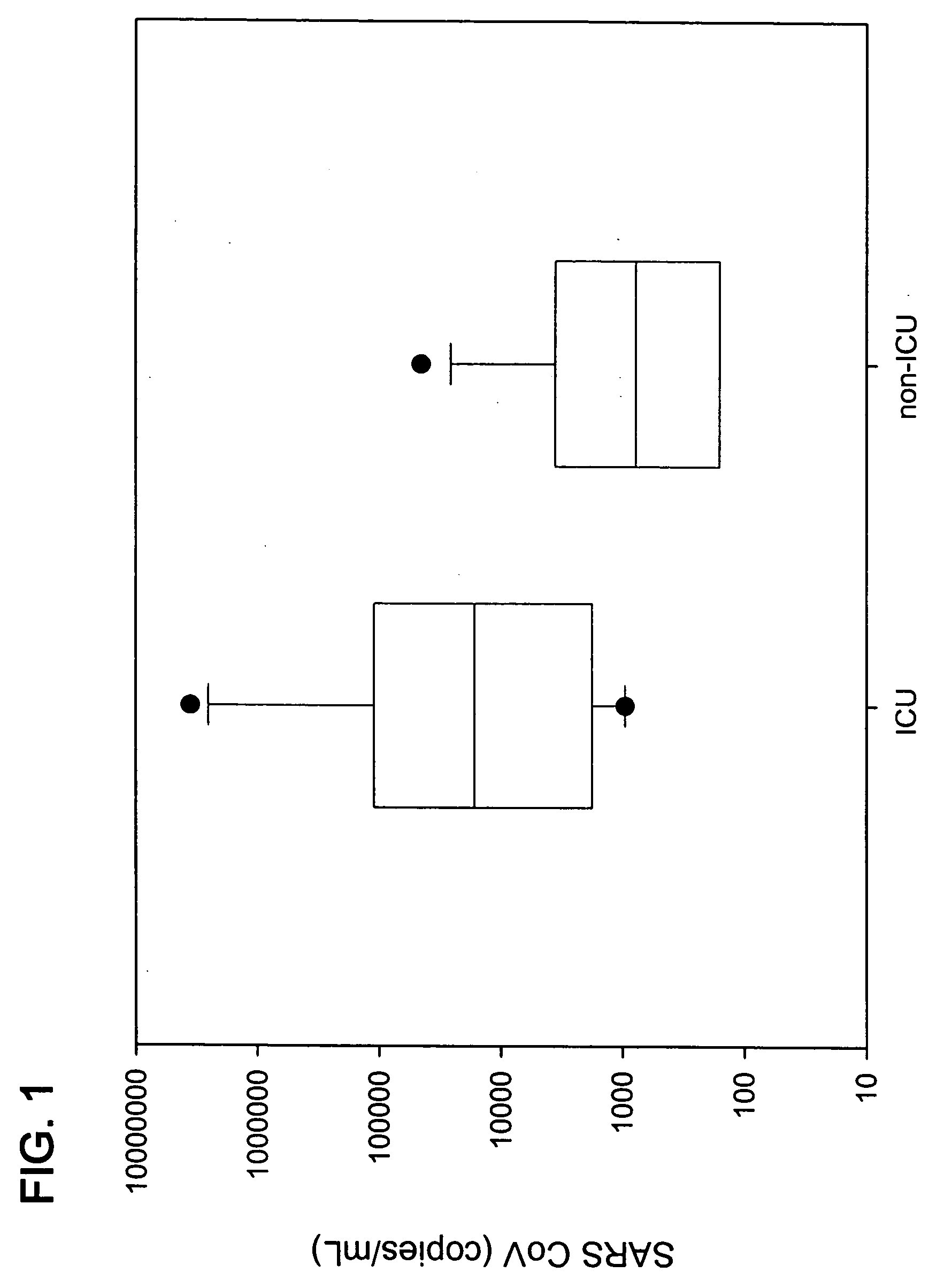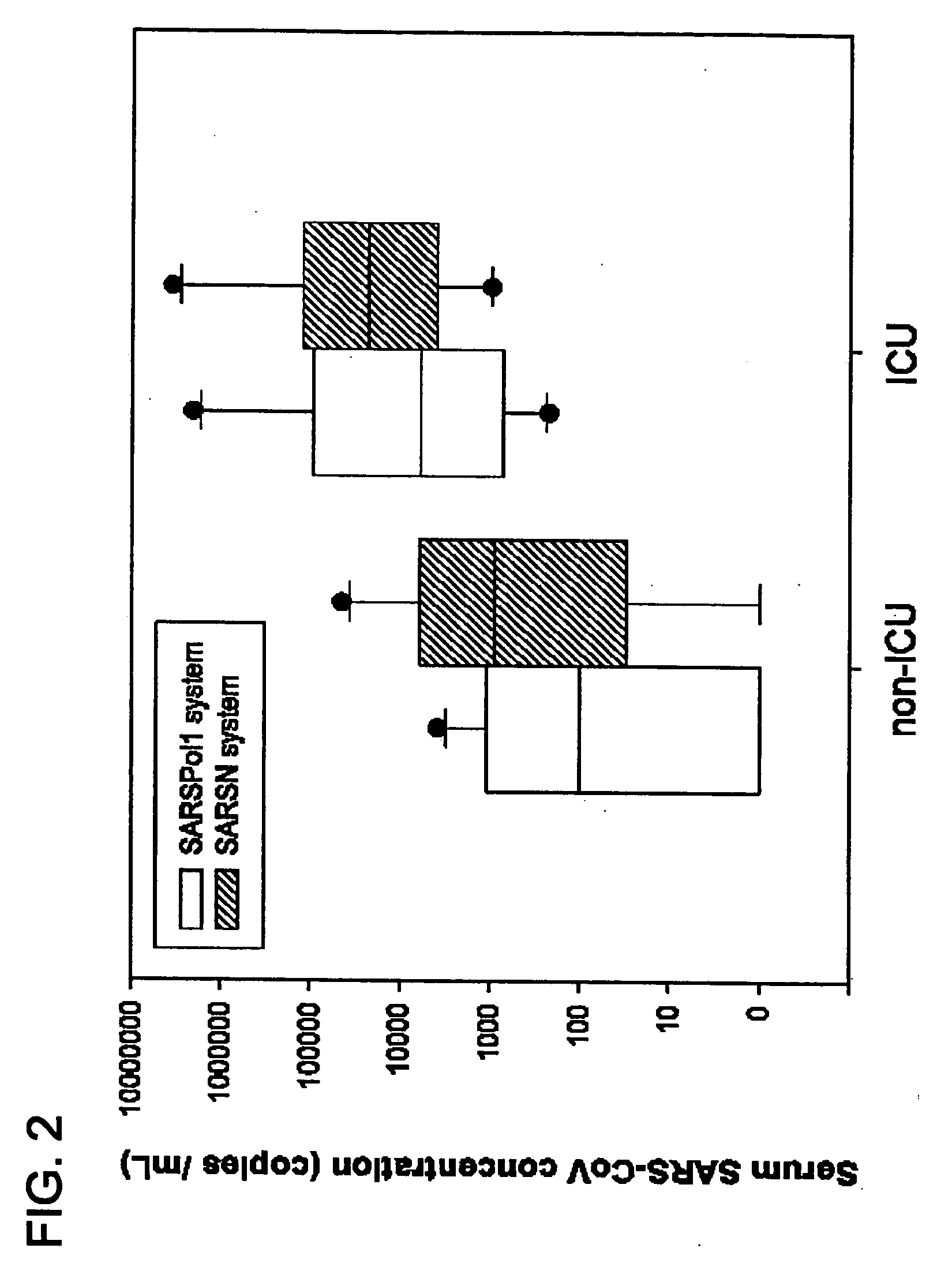Prognostic PCR assay for severe acute respiratory syndrome (SARS)
a pcr assay and severe acute respiratory syndrome technology, applied in the field of nucleic acid primers and probes, can solve the problems of paucity of data concerning the detection of sars-cov in the plasma/serum of sars patients, difficult quantitative interpretation of these data, and standardization of such data
- Summary
- Abstract
- Description
- Claims
- Application Information
AI Technical Summary
Benefits of technology
Problems solved by technology
Method used
Image
Examples
example 1
Detecting Plasma-Borne SARS Nucleic Acids and Prognostic Predictions Based on SARS Nucleic Acid Levels
[0078] To determine the detectability of SARS-CoV in plasma / serum, samples from 10 confirmed SARS patients were subjected to an optimized RNA extraction protocol and tested to determine if SARS-CoV RNA was detectable using the real-time RT-PCR assay, described below. Our results demonstrate that the plasma RNA assay is able to detect SARS-CoV in 80% (8 / 10) of the SARS patients.
[0079] In this study, patients may be categorized into two prognostic groups: (a) the poor prognostic group consists of 12 patients who required admission to the intensive care unit (ICU); and (b) the good prognostic group consists of 16 patients who did not require ICU admission. The mean ages of group (a) and (b) were 58 and 46, respectively. There was no significant different between these two groups (t-test, p=0.06). Our data showed that the detection rates of group (a) and (b) were 100% (12 / 12) and 81% ...
example 2
Detection of SARS Nucleic Acids in Pediatric Patients
[0085] Pediatric SARS patients have been reported to have a milder course of disease than adults. We investigated if SARS-CoV RNA can be detected in the plasma of pediatric patients during different stages of SARS and to study the correlation between viral loads and therapeutic treatment.
Patients and Methods
Subjects
[0086] Peripheral blood samples were collected from all confirmed pediatric SARS patients admitted to the New Territories East Cluster of Hospital Authority Hospitals in Hong Kong. Samples were recruited between 13 Mar. 2003 and 17 May 2003. Serial blood samples were obtained from 8 pediatric SARS patients, starting from the day of hospital admission. The samples were obtained during routine blood tests for monitoring lymphocyte counts and biochemical parameters and enzymes. Informed consent was obtained from the patients or their parents and ethics approval was obtained from the institutional review board. As nega...
example 3
Early Detection of SARS-CoV
[0105] The availability of an early diagnostic tool for severe acute respiratory syndrome (SARS) would be of major public health implication. We investigated if the SARS coronavirus (SARS-CoV) can be detected in serum and plasma samples during the early stage of SARS and to study the potential prognostic implications of such an approach.
Patients and Methods
Subjects
[0106] Peripheral blood samples were obtained from SARS patients admitted to the New Territories East Cluster of Hospital Authority Hospitals in Hong Kong. Samples were recruited between March 2003 and May 2003.
[0107] In the first part of this study, blood samples were collected from 12 SARS patients on the day of hospital admission, as well as at day 7 and day 14 after fever onset. Informed consent was obtained from the patients and ethics approval was obtained from the institutional review board. In the second part of this study, blood samples were obtained from 23 SARS patients on the da...
PUM
| Property | Measurement | Unit |
|---|---|---|
| Tm | aaaaa | aaaaa |
| temperature | aaaaa | aaaaa |
| temperature | aaaaa | aaaaa |
Abstract
Description
Claims
Application Information
 Login to View More
Login to View More - R&D
- Intellectual Property
- Life Sciences
- Materials
- Tech Scout
- Unparalleled Data Quality
- Higher Quality Content
- 60% Fewer Hallucinations
Browse by: Latest US Patents, China's latest patents, Technical Efficacy Thesaurus, Application Domain, Technology Topic, Popular Technical Reports.
© 2025 PatSnap. All rights reserved.Legal|Privacy policy|Modern Slavery Act Transparency Statement|Sitemap|About US| Contact US: help@patsnap.com



